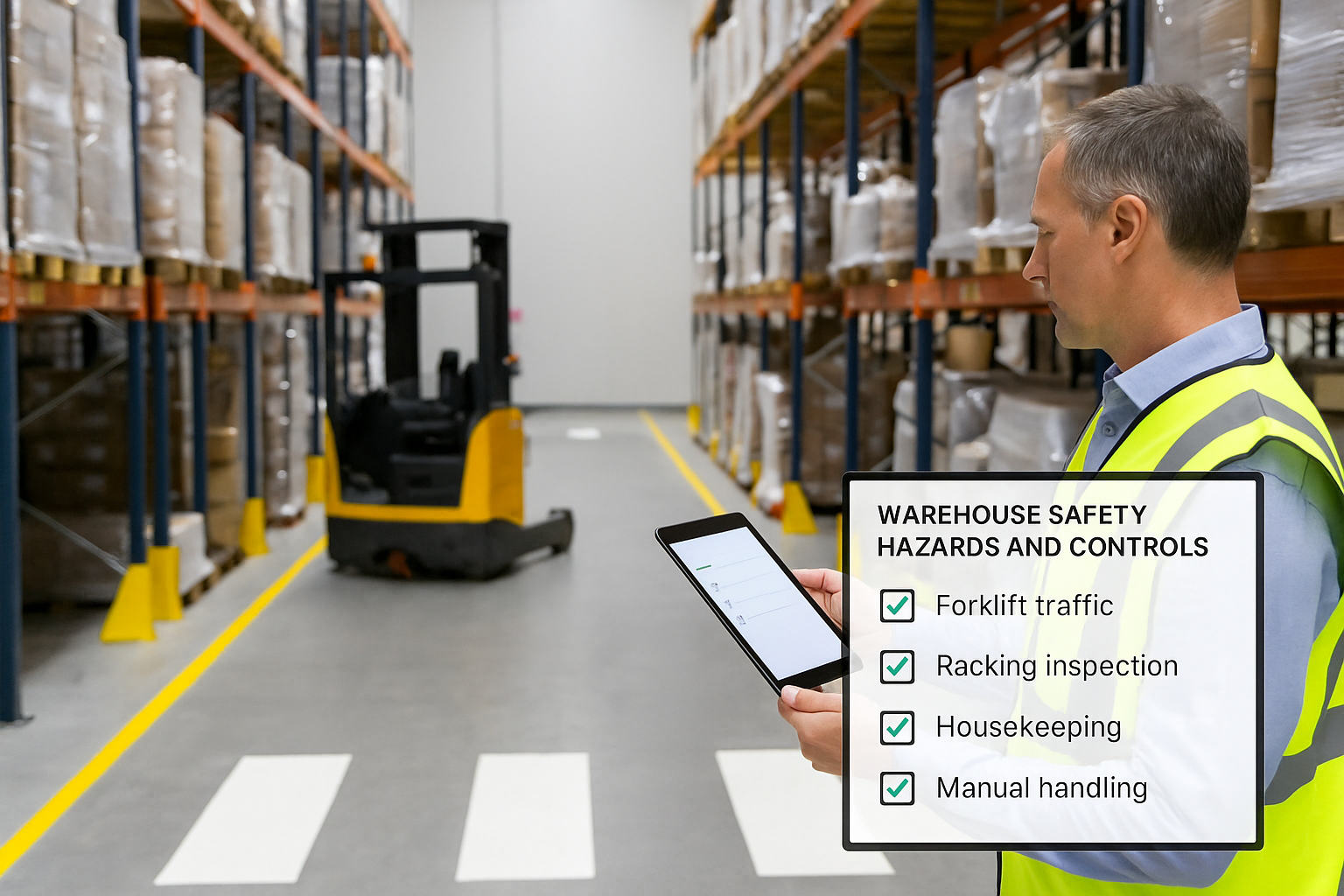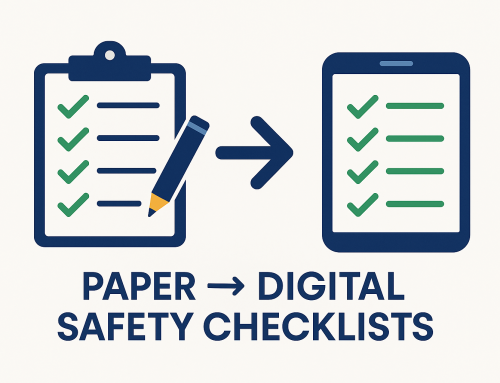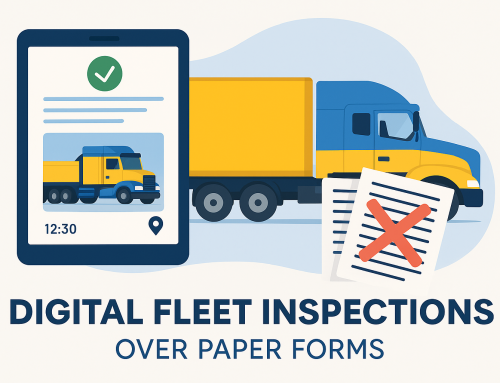Warehouse Safety Hazards and Controls: The 2025 Guide
Warehouses are fast-paced environments where warehouse safety hazards and controls determine whether your operation runs smoothly—or grinds to a halt after an incident. This practical guide maps the biggest risks, proven controls, and smart ways to hard-wire safety into daily routines using digital checklists, evidence capture, and action tracking.
Quick Highlights
- Biggest risks: forklifts/traffic, racking collapse, poor housekeeping, manual handling, falling objects.
- Controls that work: marked lanes & barriers, racking inspections, clean-as-you-go, load restraint, training & supervision.
- Make it stick: digital checklists, photos, geo-time stamps, and an Action Register to prove close-outs.
- Standards: Align with WHS duties and ISO 45001’s risk-based approach.
- Faster audits: centralised evidence and exportable audit trail.
Top Warehouse Safety Hazards & Controls
1) Mobile plant & pedestrian interaction
- Hazard: collisions between forklifts/EWP and people.
- Controls: physical barriers, one-way systems, speed limits, marked walkways, exclusion zones at loading docks, spotters for blind corners, high-vis PPE.
- Good practice: licence verification and practical competency checks.
2) Racking collapse & falling objects
- Hazard: impact damage, overloading, missing beam locks; unstable pallets.
- Controls: rated racking with load signage, beam locks, column guards, immediate isolation of damaged bays, and regular inspections by a competent person.
- Good practice: record defects with photos and barcode/asset ID to track recurrence.
3) Housekeeping, slips, trips & falls
- Hazard: debris, strapping, shrink wrap tails, spills, uneven surfaces.
- Controls: clean-as-you-go, spill kits, cable management, adequate lighting, non-slip surfaces, and storage discipline.
- Good practice: set a 5S daily routine and verify by walk-through checks.
4) Manual handling & ergonomics
- Hazard: strains from lifting, pushing, repetitive tasks.
- Controls: mechanical aids (pallet jacks, lifters), team lifts, job rotation, training on posture, and engineered heights for pick/pack benches.
5) Hazardous atmospheres & cold storage
- Hazard: poor ventilation, CO exposure from LPG forklifts, extreme cold, ice.
- Controls: ventilation/monitoring, electric forklifts where feasible, warm-up protocols, anti-slip mats, and de-icing routines.
Warehouse Risk Assessment (WHS & ISO 45001)
Effective risk management starts with identification, assessment, control selection, and review—mapped to WHS duties and ISO 45001’s Plan-Do-Check-Act cycle. Use a standardised matrix, capture evidence (photos/notes), assign actions, and verify close-out.
- Identify tasks, equipment, traffic flows, and seasonal variations (e.g., peak season congestion).
- Assess likelihood/severity; prioritise high-risk interactions like forklift–pedestrian crossovers.
- Implement controls using the hierarchy (eliminate → substitute → engineer → admin → PPE).
- Monitor and review after incidents, near misses, or changes to layout/workload.
Recommended further reading: RMIT: Using digital technology to share WHS knowledge and EU-OSHA: Smart digital systems improve OSH.
Forklift & Pedestrian Separation
- Designated, colour-contrasted walkways with continuous barriers.
- Give pedestrians the right of way with controlled crossings and look-both-ways signage.
- Speed limits, horns at intersections, strobe/sound alerts on vehicles, mirrors for blind spots.
- High-risk tasks (loading docks) require documented exclusion zones and spotters.
- License checks + practical competency verifications—recorded and refreshed.
Racking Safety & Inspections
- Ensure rated components, load signage, beam locks; never exceed specified loads.
- Visually inspect bays weekly; perform formal, competent inspections at defined intervals.
- Tag/lock-out damaged racking immediately; document with photos; track in an Action Register.
- Stability: stack pallets evenly; restrain unstable loads; maintain safe clearances.
Housekeeping, Slips, Trips & Falls
- Adopt clean-as-you-go; audit with a short daily 5S checklist.
- Use spill kits and documented spill response steps.
- Ensure even lighting; repair uneven flooring and trip hazards quickly.
- Keep fire exits and eyewash paths clear; verify during safety walks.
Manual Handling & Ergonomics
- Reduce lift frequency/weight via mechanical aids and better pick-face design.
- Train on posture, push vs pull, and team lifting protocols.
- Rotate tasks to limit repetition; set bench heights to neutral posture.
How to Run a Weekly Warehouse Safety Walk (10–15 mins)
- Plan the route: aisles, docks, battery bays, pedestrian crossings.
- Check separation: barriers intact, walkways clear, signage visible.
- Scan housekeeping: spills, debris, wrap tails, blocked egress.
- Spot racking issues: beam locks, damage, overload signs.
- Look for unsafe acts/conditions: speed, cornering, PPE use.
- Capture evidence on a mobile checklist (photos, notes, geo-time stamps).
- Assign corrective actions on the spot; set owners and due dates.
- Review last week’s open items; close out what’s verified as fixed.
Paper vs Digital Checks in the Warehouse
| Aspect | Paper Checklists | Digital Checklists (DIGI CLIP) |
|---|---|---|
| Evidence quality | Handwritten notes; photos stored separately | Photos, signatures, geo-time stamps embedded in the submission |
| Action tracking | Manual follow-ups; hard to audit | Actions auto-created, assigned, and tracked in an Action Register |
| Audit readiness | Scattered files; time-consuming retrieval | Centralised, exportable audit trails and dashboards |
| Speed | Slow to compile and share | Instant sharing; automated email alerts and summaries |
| Offline work | N/A | Forms can be submitted when connectivity returns. |
Case Study: Faster Close-Outs, Fewer Incidents
Profile: Mid-size Adelaide cold-store warehouse struggling with near-misses at pedestrian crossings and repeated racking damage.
- What changed: Introduced daily 5-minute walk-throughs, weekly racking checks, and forklift start-of-shift inspections using DIGI CLIP.
- Results (6 months): 12% fewer near-miss reports, 15% faster corrective-action close-outs, and measurable drop in racking damage reoccurrence.
- Why it worked: Evidence-rich reports (photos + geo-time stamps) and a visible Action Register drove accountability.
“Our teams know issues are logged with photos and must be closed out and comminicated. That visibility alone lifted our safety culture.” — David A, SA cold storage facility
About DIGI CLIP Mobile Forms
DIGI CLIP is a mobile checklist and inspection app that simplifies safety, compliance, and operational reporting. Designed for industries like transport, warehousing, agriculture, and construction, DIGI CLIP replaces paper forms with real-time digital checklists. Built-in photo capture, automated alerts, geo-time stamping, and an Action Register ensure nothing gets missed.
Why Try DIGI CLIP? Because safety actions don’t count if you can’t prove them. Start your free trial—no credit card needed—and see how simple compliance can be.
Recommended Reading on DIGI CLIP
External Guidance
Conclusion: Make Warehouse Safety Visible—and Verifiable
Warehouse safety hazards and controls are only effective when they’re consistently applied and evidenced. Prioritise the big risks—traffic separation, racking integrity, housekeeping, and manual handling—then hard-wire simple checks into daily and weekly rhythms. Capture photos, time/location details, and assign actions so close-outs are provable and audit-ready.
With DIGI CLIP, your checks become data, and your data becomes proof. Forms can be submitted when connectivity returns. Turn safety from paperwork into performance.
FAQs- Warehouse Safety Hazards and Controls
What are the most common warehouse hazards?
Mobile plant/pedestrian interaction, racking collapse, poor housekeeping (slips/trips), manual handling strains, and falling objects are the big five. Address these first with engineered controls, clear rules, and routine inspections.
How often should we inspect warehouse racking?
Adopt frequent visual checks (e.g., weekly), plus scheduled inspections by a competent person. Isolate damaged bays immediately, record evidence (photos), and track corrective actions in an Action Register.
What’s the best way to separate forklifts and pedestrians?
Use continuous barriers, marked walkways, controlled crossings, mirrors at blind corners, speed limits, and trained spotters for loading docks. Verify daily with short walk-through checks.
How does ISO 45001 apply to warehouses?
ISO 45001 requires a risk-based safety management system with worker participation and continuous improvement. Map hazards, evaluate risks, implement controls, and monitor performance with audits and dashboards.
How can digital checklists improve warehouse safety?
Digital checklists improve evidence quality (photos, signatures, geo-time stamps), automate action tracking, and create an exportable audit trail. Forms can be submitted when connectivity returns.
Can DIGI CLIP support our warehouse audits?
Yes. DIGI CLIP standardises inspections (e.g., racking, traffic, housekeeping), assigns corrective actions with due dates, and centralises proof for faster audits and regulator or customer reviews.
If you liked this post? Why not share it!








Leave A Comment